This module defines and analyses the process of Risk Analysis.
It starts with giving a definition of it, and then it moves on explaining the different methodologies to execute it.
First of all, it gives the distinction between qualitative and quantitative risk analysis. After this distinction it goes on explaining different methods for the realisation of a risk analysis and their areas of implementation.
The module is divided into two Units which are then divided into several sections.
|
|
 Risk Analysis Risk Analysis
Definition of Risk Analysis Click to read Click to read
Risk analysis is the process of determining the likelihood of risk in a project. It investigates the uncertainty of prospective risks and how they might affect the project in terms of time, quality, and money if they occurred
|
Why?
Risk analysis is critical for establishing the worthiness of a certain project or investment and the appropriate process(es) to manage such risks.
|
|
How?
A risk analyst begins by determining what may go wrong. These disadvantages must be balanced against a probability meter that assesses the chance of the event occurring.
|
| |
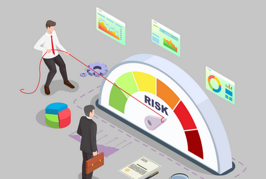 |
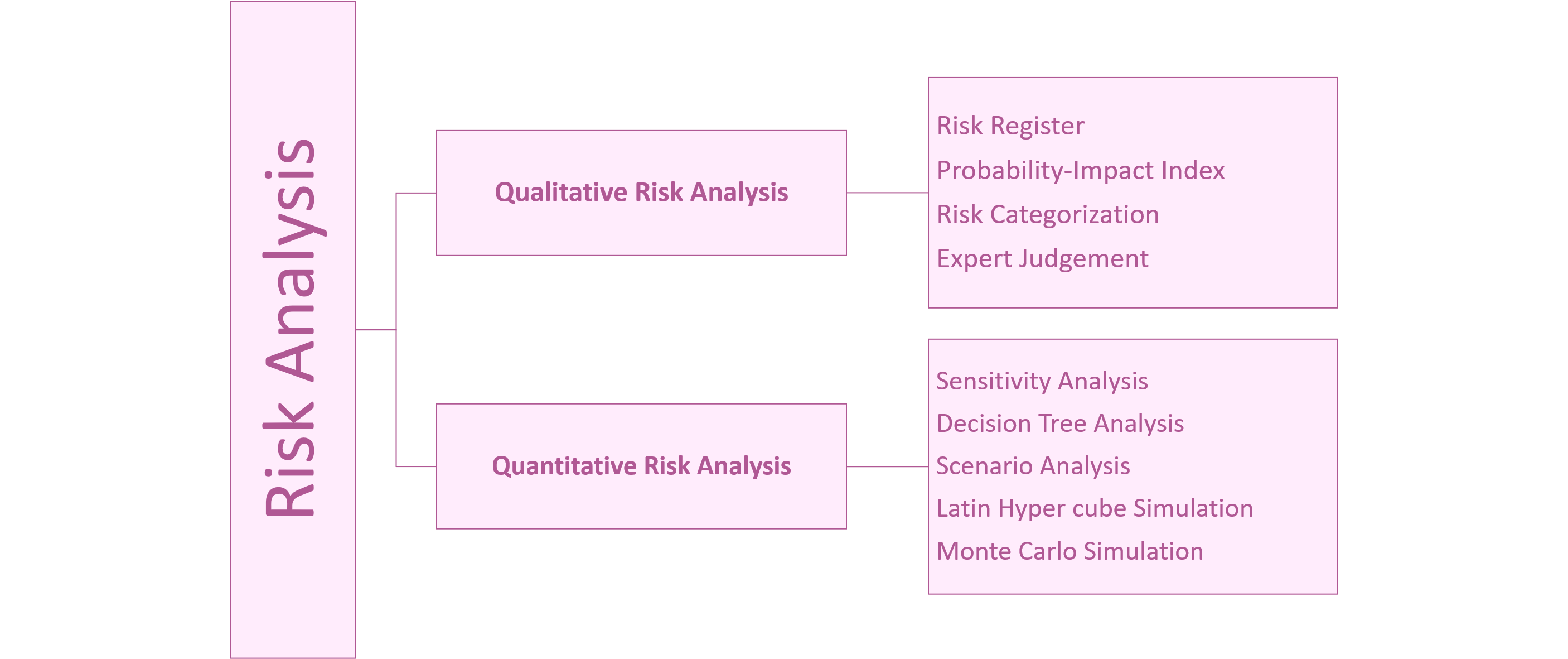
Qualitative Risk Analysis Click to read Click to read
The qualitative risk analysis is a risk assessment performed by project team specialists who use data from previous projects and their knowledge to determine the impact and likelihood value for each risk on a scale or risk matrix.
|
The scale is typically rated from zero to one. That is, if the likelihood of the risk occurring in the project is 0.5, it has a 50% chance of occurring
|
 |
There is also an effect scale that ranges from one to five, with five having the most impact on the project. The risk will then be classified as source- or effect-based.
|
 |
Once risks have been identified and examined, a member of the project team is appointed as the risk owner for each risk. They are in charge of developing and implementing a risk response strategy.
|
Quantitative Risk Analysis  Click to read Click to read
The quantitative risk analysis is a statistical examination of the impact of the identified risks on the entire project. This enables project managers and team leaders to make choices with less ambiguity and aids the risk-control process.
|
Quantitative risk analysis analyses the various project outcomes and calculates the likelihood of attaining project objectives.
|
 |
This aids decision-making, especially during the project planning phase when there is ambiguity.
|
 |
It assists project managers in developing realistic cost, schedule, and scope objectives.
|
Qualitative vs. Quantitative Analysis Click to read Click to read
| Qualitative Analysis |
Quantitative Analysis |
- Analytical process that does not use numerical and quantitative evaluations to identify and assess hazards.
|
- It involves numerical and quantitative evaluations.
|
- It can be done in every kind of project.
|
- It is not required for all projects; in some kinds of them it can be avoided.
|
- It gives a subjective evaluation of probability and impact.
|
- Gives an objective evaluation and a probabilistic estimate of time and costs.
|
|
|
- It’s more time consuming than a qualitative analysis.
|
- No specific software or tools required.
|
- It may require some special tools to be realised.
|
Summing up Click to read Click to read
| Summing up |
 |
Risk Analysis
The process of determining the likelihood of risk in a project. |
|
 |
Types of risk analysis
|
|
 |
Qualitative Risk Analysis
Determines the impact and likelihood value for each risk on a scale or risk matrix. |
| |
|
|
|
|
|
|
|
 |
Quantitative Risk Analysis
Statistical examination of the impact of the identified risks on the entire project. |
|
 |
Quantitative vs. Qualitative
- Analytical vs. numerical
- Subjective vs. objective
|
 Methodologies and approaches to Risk Analysis Methodologies and approaches to Risk Analysis
The approaches  Click to read Click to read
Several risk analysis approaches exist to assist managers in the analysis and decision-making process.
 |
Bow Ties Analysis |
 |
Risk Analysis Matrix ( + Risk Register, i.e. protocols and responsabilities) |
 |
SWIFT Analysis |
Bow Ties Analysis  Click to read Click to read
The Bow Tie Analysis is a graphical depiction of new suitable pathways leading to risk prevention and safety measures that could be needed at organisation level, or per any given process / function.
|
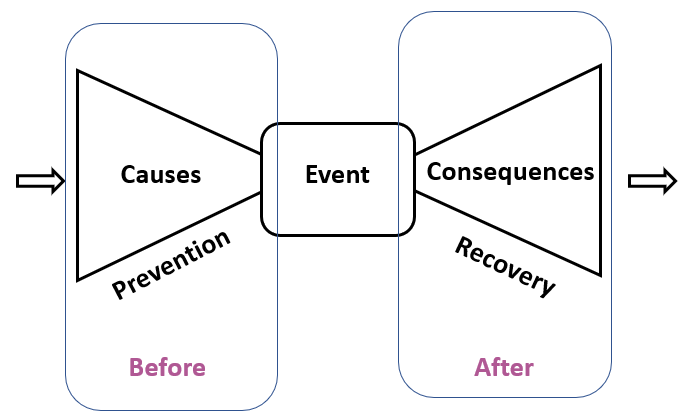 |
Risk Analysis Matrix  Click to read Click to read
|
The risk analysis matrix ranks the severity of any given risk based on the likelihood and impact of the disruption associated.
Its primary goal is to assist managers in prioritizing risks and developing a risk management strategy that includes the appropriate resources and tactics for risk mitigation.
|
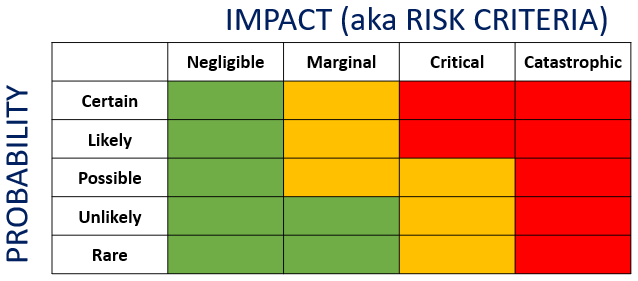 |
Risk register Click to read Click to read
|
A risk register is a repository in which outputs of risk management processes are recorded. Information in a risk register can include the person responsible for managing the risk, probability, impact, risk score, planned risk responses, and other information used to get a high-level understanding of individual risks.
|
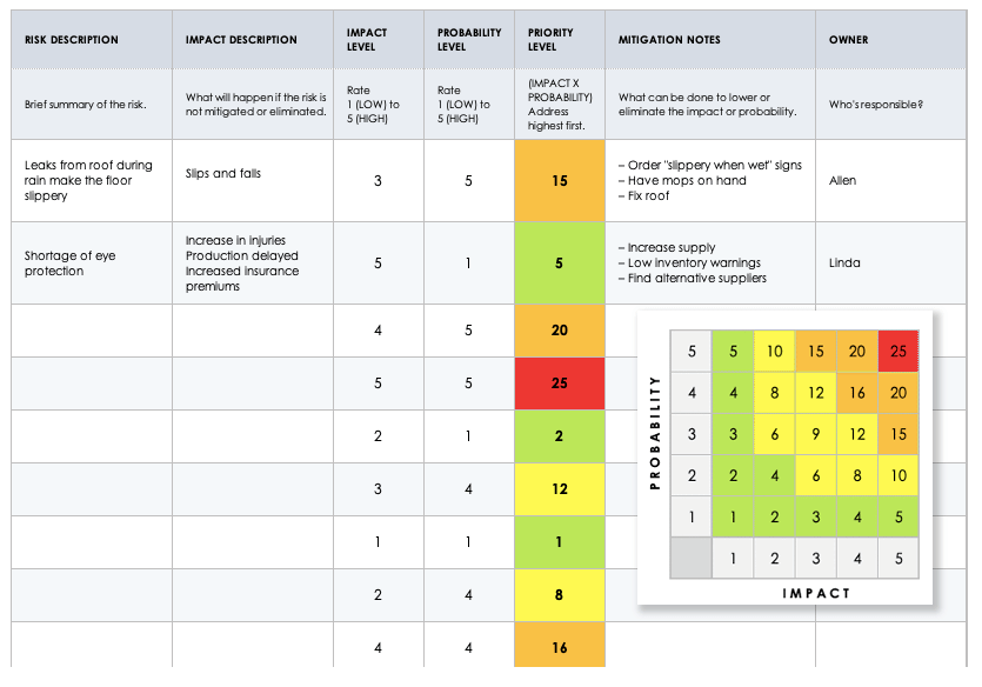 |
Source: PMP Management Book, Seventh Edition, July 2021.
Swift Analysis  Click to read Click to read
|
SWIFT is an acronym that stands for Structured What If Technique.
It is a risk analysis strategy that focuses on detecting possible hazards connected with project plan modifications.
As the term implies, team members must generate as many “what if” questions as possible in order to identify all potential hazards.
|
SWIFT employs structured brainstorming, which combines a pre-set of guidewords (such as scheduling, amount, etc.) with participant-generated prompts that frequently start with questions like "what if?" or "how could?".
With the aid of the guidewords and "what if?" questions, the facilitator invites the group to bring up and discuss issues like:
|
 |
Known risks |
 |
Risk sources and drivers |
 |
Previous experience, successes and incidents |
 |
Known and existing controls |
 |
Regulatory requirements and constraints |
Summing up Click to read Click to read
| Summing up |
| |
|
|
 |
Methods for Risk Analysis
- Bow Ties Analysis
- Risk Analysis Matrix
- Risk Register
- SWIFT Analysis
|
|
|
|
|
Qualitative Risk Analysis – Quantitative Risk Analysis – Risk Analysis Matrix – Risk Register – SWIFT Analysis
- Learn the definition of Risk Analysis
- Learn the difference between Qualitative and Quantitative Risk Analysis
- Distinguish between different methods of risk analysis
 Risk Analysis
Risk Analysis


 Risk Analysis
Risk Analysis Click to read
Click to read 






